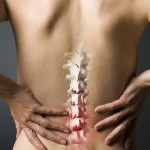Keeping Back Pain Away
By Dr. Cynthia Horner
Understanding what causes back pain and how to recognize problems before they are bad enough to create pain that disrupts your life is what I will discuss in the next few paragraphs. Seventy five percent of all human beings will experience low back pain severe enough to keep them from their daily activities. Not just adults but people of all ages and from all walks of life. Why do so many people have back pain? I blame those early humans who arranged a few large rocks together and uttered the word “chair”.
is what I will discuss in the next few paragraphs. Seventy five percent of all human beings will experience low back pain severe enough to keep them from their daily activities. Not just adults but people of all ages and from all walks of life. Why do so many people have back pain? I blame those early humans who arranged a few large rocks together and uttered the word “chair”.
Sitting and Back Pain
Sitting for long periods of time as modern humans do, does not promote good, balanced body structure. The seated position keeps many muscles in an unnatural shortened state. When you spend hours each day training your muscles to be short they do just that, stay short.
Muscles that become short and contracted create dysfunction in three ways:
- Muscles become weak and fail us.
- Muscles continuously pull on the bones that anchor them, causing joint misalignments.
- Misaligned vertebrae create disc problems.
Which Muscles Are We Talking About?
The two muscles groups most involved with sitting and low back pain are your hamstrings and psoas. Your hamstrings at the back of your thighs, attach to the lower back of your pelvis to what is commonly called your ‘sits’ bone and extend down the back of your leg to anchor just below the back of your knee. In the act of sitting you tuck your pelvis, bringing your pubic bone upward and the back of your pelvis downward and bend your leg at the knee, this position puts your hamstrings in a short contracted position. A person with short contracted hamstrings usually stands with a flat lower back. The natural inward curve just above the buttocks is important in maintaining a healthy spine and healthy discs.
Also involved in causing back pain are your hip flexors. Hip flexors are a group of muscles but the psoas are the ones most commonly involved with back problems. You have two psoas, one on each side of your spine. They attach to the front of vertebrae and discs of your lower spine and anchor on your upper, inner, front thigh. They are major players in lifting your leg to step up into a car or truck. The very act of sitting greatly shortens these two muscles unfortunately usually more on one side than the other. Their shortened state causes them to create a constant uneven pull on low back vertebrae and discs.
Weak, Short Hamstrings + Weak, Short Psoas = Back Pain
The combined, constant, pull of the hamstrings in the back and psoas in the front puts the pelvis and spine in an unnatural position. To complicate things even more these muscles do not shorten or pull on the spine equally. More often one side is tighter and therefore pulls harder and is weaker than the other. How you stand, walk, sit and sleep either trains these muscles to stay in a constant, shorten position or a balanced, lengthened position.
Just Getting Rid of the Pain is Not Solving the Problem
Simply making the pain go away is not the solution to your back problem. The pain you feel is your body’s way of telling you to stop what you are doing because if you continue you are about to cause further damage to your body especially your nervous system. Correcting the structure imbalance is the only way to correct the problem and ensure it does not return this is done through chiropractic adjustments. A chiropractic adjustment uses movement and touch to stimulate the brain to lay new pathways that re-train or re-pattern how you carry your body while in motion and at rest.
This is the work I do with my patient. My goal is to make you independent of chiropractic care for your pain and dependent on your own knowledge and new improved postural habits to carry you through a pain free more enjoyable life.
What my patients have taught me “It is easier to use chiropractic to stay well than to repeatedly get well.”